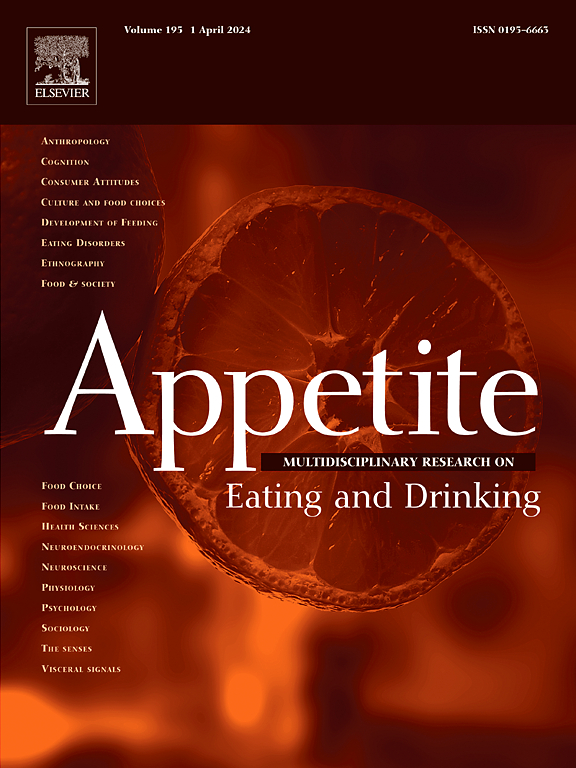Sensitization of the reinforcing value of food is associated with greater BMI percentile in lower income adolescents
IF 4.6
2区 医学
Q1 BEHAVIORAL SCIENCES
引用次数: 0
Abstract
Sensitization, or the increase in the reinforcing value of high energy density snack food (RVFOOD) after repeated daily intake, is associated with weight and weight change in adolescents. The purpose of this study was to examine the relationships among reinforcer sensitization, delay discounting (DD), and BMI percentile in a lower income sample who experience higher rates of food insecurity (FI). We hypothesized that the relationship between sensitization and BMI percentile is moderated by FI and DD. We conducted an observational cohort study in 118, 11–14 year old adolescents from lower income households. The RVFOOD of a preferred HED food was assessed at baseline and after 2 weeks of daily intake. We also assessed DD and household and adolescent reported FI. Sensitization, but not baseline RVFOOD, was positively associated with BMI percentile, but this effect was not moderated by household or adolescent FI or by DD. Both adolescent and household FI were associated with higher baseline RVFOOD, creating a potential ceiling effect and suggesting that adolescents who are FI may enter the study “pre-sensitized” to the snack foods. This study replicates and extends our prior findings showing that sensitization is related to higher BMI percentile in lower income adolescents, but these effects were not moderated by FI. Food insecurity, in particular when reported by the adolescent, was related to DD and baseline RVFOOD which can impact food intake, diet, and weight status.
在低收入青少年中,食物强化价值的敏化与较高的BMI百分位数有关
致敏,即每天重复摄入高能量密度零食(RVFOOD)后强化值的增加,与青少年的体重和体重变化有关。本研究的目的是在一个经历较高粮食不安全(FI)率的低收入样本中检验强化物敏化、延迟折扣(DD)和BMI百分位数之间的关系。我们假设致敏性和BMI百分位数之间的关系受到FI和DD的调节。我们对118,11 - 14岁的低收入家庭青少年进行了一项观察性队列研究。首选HED食物的RVFOOD在基线和每日摄入2周后进行评估。我们还评估了DD以及家庭和青少年报告的FI。致敏性(而非基线RVFOOD)与BMI百分位数呈正相关,但这种影响并没有被家庭或青少年FI或DD所缓和。青少年和家庭FI都与较高的基线RVFOOD相关,这产生了潜在的天花板效应,表明FI青少年可能进入研究时对零食“预致敏”。这项研究重复并扩展了我们之前的研究结果,即在低收入青少年中,致敏与较高的BMI百分位数有关,但这些影响并没有被FI所缓和。粮食不安全,特别是当青少年报告时,与DD和基线RVFOOD相关,这可能影响食物摄入、饮食和体重状况。
本文章由计算机程序翻译,如有差异,请以英文原文为准。
求助全文
约1分钟内获得全文
求助全文
来源期刊

Appetite
医学-行为科学
CiteScore
9.10
自引率
11.10%
发文量
566
审稿时长
13.4 weeks
期刊介绍:
Appetite is an international research journal specializing in cultural, social, psychological, sensory and physiological influences on the selection and intake of foods and drinks. It covers normal and disordered eating and drinking and welcomes studies of both human and non-human animal behaviour toward food. Appetite publishes research reports, reviews and commentaries. Thematic special issues appear regularly. From time to time the journal carries abstracts from professional meetings. Submissions to Appetite are expected to be based primarily on observations directly related to the selection and intake of foods and drinks; papers that are primarily focused on topics such as nutrition or obesity will not be considered unless they specifically make a novel scientific contribution to the understanding of appetite in line with the journal's aims and scope.
 求助内容:
求助内容: 应助结果提醒方式:
应助结果提醒方式:


